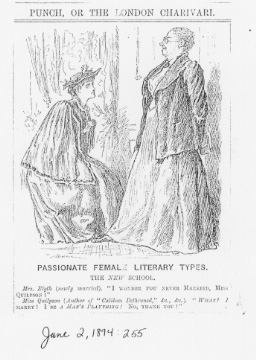
Punch, 33 (June 2, 1894): 255

 he NEW School or the "new woman" was viewed by many as turning women into man and destroying the possibilities of marriage. The interaction between the newly married attractive woman and the older female intellect proves this belief. Young Mrs. Blythe looks as if she is bowing down to the elder Miss Quilpson. Although she is actually sitting down, she is still in the passive position. The young woman has the same gentile expression reminiscent of Du Maurier's earlier angelic mothers and wives. Quilpson, who represents the new school of female literary types, looks down upon the institute of marriage and thus the home. She is far from any man's ideal type. The joke as Du Maurier meant it, was that this woman could not marry if she wanted to. Her spectacles and underbite add to her unattractive appearance. She is wearing a masculine coat and she holds a book behind her, instead of clasping her hands in the same composed and delicate manner as Mrs. Blyth. The difference between the facial angles is also very interesting. Mrs. Blythe has the perfect ninety degree form, while her intellectual superior, Miss Quilpson is drawn with a smaller angle. This places her in the undesirable lot of the Irish and other lesser breeds. The educated woman, the "new woman" is not a sweet girl, but rather a masculine spinster.
he NEW School or the "new woman" was viewed by many as turning women into man and destroying the possibilities of marriage. The interaction between the newly married attractive woman and the older female intellect proves this belief. Young Mrs. Blythe looks as if she is bowing down to the elder Miss Quilpson. Although she is actually sitting down, she is still in the passive position. The young woman has the same gentile expression reminiscent of Du Maurier's earlier angelic mothers and wives. Quilpson, who represents the new school of female literary types, looks down upon the institute of marriage and thus the home. She is far from any man's ideal type. The joke as Du Maurier meant it, was that this woman could not marry if she wanted to. Her spectacles and underbite add to her unattractive appearance. She is wearing a masculine coat and she holds a book behind her, instead of clasping her hands in the same composed and delicate manner as Mrs. Blyth. The difference between the facial angles is also very interesting. Mrs. Blythe has the perfect ninety degree form, while her intellectual superior, Miss Quilpson is drawn with a smaller angle. This places her in the undesirable lot of the Irish and other lesser breeds. The educated woman, the "new woman" is not a sweet girl, but rather a masculine spinster.
Please turn to my next cartoon
[Victorian initial "T" by Harlan Wallach ©copyright 1994.]